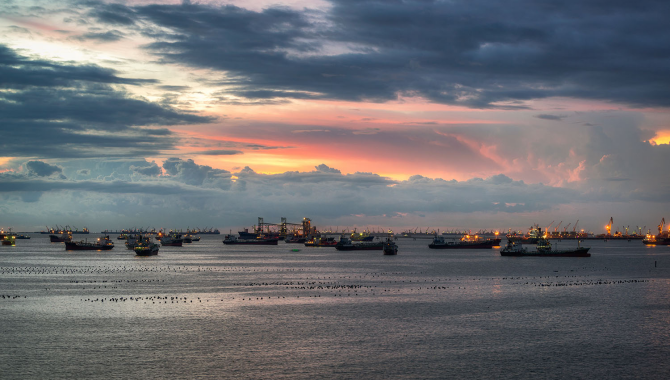The Carbon Intensity Indicator (CII) regulations have been in force since 1 January 2023 and in March 2024, new carbon intensity ratings will be assigned. With that, CII is likely to come back to owners’ and charterers’ attention.
Last year saw BIMCO publish their CII clause for time charterparties which we covered in
this article. Now, on 20 October 2023, they issued a
new CII clause for voyage charterparties.
Simpler and easier
As expected, the voyage charter clause is much simpler than its time charter equivalent, and we think it will also be easier for owners and charterers to agree. As BIMCO point out in the preamble to the clause, the wording is largely based on the BIMCO Slow Steaming Clause for Voyage Charter Parties 2012. This will likely make negotiations simpler but there are still some areas that parties should understand.
First, the clause is intended to override any other provisions in the charter party. Care must therefore be taken, particularly when introducing bespoke rider clauses and amending standard proforma forms.
Right to adjust
Sub-clause (a) is a key part of the clause. It says that, subject to owners maintaining a minimum agreed speed in agreed good weather conditions, owners have the right to “adjust course and/or to reduce speed or RPM…”, but only “[w]ith a view to reducing the carbon intensity of the Vessel…”. In other words, it does not excuse a breakdown.
An important difference between the clause and the BIMCO Slow Steaming Clause is the owners’ right to adjust course. Including that right in sub-voyage charters will be particularly important for two groups: first, for vessel owners who voyage charter out, but who want to be entitled to take steps to maintain their vessel’s CII rating; and second, for charterers who take vessels in on time charter and then voyage charter out. If their time charters apply the BIMCO CII Clause for Time Charter Parties (or something similar), then the Master is generally required to proceed “by the most fuel-efficient route”. Owners have also additional rights to alter course when the trajectory of the vessel’s CII starts deviating from the contractually agreed rating. In that case, the charterer needs to ensure the owners’ actions do not result in a breach of the voyage charter party.
We anticipate that this part of the clause is unlikely to cause significant issues. Many owners are already able to estimate their emissions for specific voyages with reasonable accuracy. The element that is less predictable is the time spent at anchor (i.e. demurrage), which we touch upon below.
Consequential provisions
The remaining provisions are largely consequential and already known from the BIMCO Slow Steaming Clause.
Providing that the owners exercise their right to reduce speed and/or adjust the course as prescribed by the clause, under sub-clause (b), they will not be in breach of “any obligation requiring the Vessel to proceed by the usual/customary route and/or with utmost and/or due despatch (or any other such similar/equivalent expressions)…”.
The laycan date is expressly excluded from the effect of the clause, so that it will remain the same even if the vessel reduces speed or changes course.
As already mentioned, the clause is generally intended to override other clauses in the charter. However, sub-clause (d) carves out of “any other express or implied rights under this Charter Party entitling the Vessel to proceed at speeds below the minimum speed stated in subclause (a)”. In other words, the clause gives the vessel new rights to reduce speed for CII purposes, but it does not prevent even slower speeds being permissible where already covered by the charter. As BIMCO point out, this could cover emergency and safety situations but careful review of other provisions in the intended form and riders is advised.
Demurrage
The clause does not address demurrage. The explanatory notes state that the drafting committee considered it best to leave this aspect to the market – a view which seems sensible to us.
Where conditions allow it, we suspect that many owners under voyage charter parties will continue to want to arrive early and earn demurrage. This could particularly be the case for long-term period head charters without any CII provision or for ships towards the end of their lifecycle.
One possible solution, albeit complex, would be a charter with a ‘just in time’ arrival provision and a “stepped” demurrage rate accounting for different periods of potential delay.
Recommendation
In conclusion, the BIMCO CII Clause for Voyage Charter Parties is a well-drafted clause that we recommend for use in voyage charters, particularly where the head owners intend to take active steps to maintain CII ratings, or where disponent owners have chartered in on terms that allow speed/route adjustments for CII purposes (such as under the BIMCO CII Clause for Time Charters).
Source:
Gard
The opinions expressed herein are the author's and not necessarily those of The Xinde Marine News.
Please Contact Us at:
media@xindemarine.com


 Ningbo Containerized Freight Index Weekly Commentar
Ningbo Containerized Freight Index Weekly Commentar  Ningbo Containerized Freight Index Weekly Commentar
Ningbo Containerized Freight Index Weekly Commentar  Ningbo Containerized Freight Index Weekly Commentar
Ningbo Containerized Freight Index Weekly Commentar  BIMCO Shipping Number of the Week: Bulker newbuildi
BIMCO Shipping Number of the Week: Bulker newbuildi  Ningbo Containerized Freight Index Weekly Commentar
Ningbo Containerized Freight Index Weekly Commentar  Ningbo Containerized Freight Index Weekly Commentar
Ningbo Containerized Freight Index Weekly Commentar